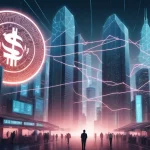Bank of Korea Slams Non-Bank KRW Stablecoins, Warns of Financial Chaos

Bank of Korea Warns of Non-Bank KRW Stablecoin Risks, Fears Financial Chaos
South Korea’s central bank has dropped a bombshell on the buzzing stablecoin scene, with Bank of Korea (BOK) Governor Lee Chang-yong sounding a loud alarm over non-bank entities issuing Korean Won (KRW)-pegged stablecoins. Speaking at a recent press conference, Lee didn’t hold back, comparing the potential mess to the lawless Free Banking Era of 19th-century America, when private currencies turned the financial system into a damn circus. This warning comes as South Korea grapples with balancing crypto innovation and economic stability.
- Main Issue: Non-bank KRW stablecoins could screw up monetary policy and foreign exchange rules.
- Historical Parallel: BOK likens unchecked issuance to the chaotic US Free Banking Era.
- CBDC on Hold: Hank River Project paused amid stablecoin legalization uncertainty.
South Korea Stablecoin Regulation: A Tightrope Walk
Stablecoins, for the uninitiated, are digital currencies designed to keep a steady value by pegging to something stable like fiat currency—here, the Korean Won. They promise the perks of crypto—fast, borderless transactions—without the rollercoaster rides of Bitcoin’s price swings. South Korea, with its tech-hungry population and massive crypto adoption, is a hotbed for such innovation. But Governor Lee is waving a red flag: if non-bank players like tech giants, crypto exchanges, or blockchain startups start minting KRW stablecoins without strict oversight, it could be a disaster for the central bank’s grip on the economy, as highlighted in a recent report on BOK’s concerns over market confusion.
Let’s break it down. Monetary policy is the BOK’s playbook for managing how much money circulates and keeping prices from going haywire—think adjusting interest rates or printing cash. If a bunch of unregulated stablecoins flood the market, tracking and controlling that money supply becomes a nightmare. Then there’s foreign exchange regulations, rules that keep the Won’s value stable on the world stage. Decentralized stablecoins could sidestep these controls, letting money flow across borders unchecked. It’s not just theory; it’s a recipe for chaos.
“If multiple non-bank institutions issue won-pegged stablecoins, it could lead to confusion similar to that caused by private currency issuance in the 19th century,” warned Lee Chang-yong.
A History Lesson with Bite: The Free Banking Era
Lee’s nod to the US Free Banking Era (1837-1864) isn’t just academic trivia—it’s a gut punch of a warning. Back then, private banks printed their own money with zero federal oversight, leading to a mess of fraud, bank busts, and worthless notes. Imagine walking into a store with cash that might not be accepted because nobody trusts the issuer. Lee’s saying we could face a modern rerun if non-bank KRW stablecoins proliferate without guardrails. Think a shady blockchain startup issues a “stable” Won with nothing backing it—when it flops, users are left holding digital toilet paper.
“In such a situation, it would be difficult to implement monetary policy, and adverse effects such as having to go through the process of returning to a central bank system again could arise,” Lee emphasized.
Stablecoins vs. Traditional Banks: A Threat to Profits?
The ripple effects don’t stop at policy. Lee pointed out that if non-bank entities issue stablecoins and handle payments directly, it could gut South Korea’s traditional banking sector. Banks make their money by facilitating payments and holding deposits—now picture a crypto exchange or tech mogul acting as your bank, minus the safety nets like deposit insurance or regulatory oversight. It’s a seismic shift that could tank banks’ bottom lines while raising big questions about trust and stability. Could a Silicon Valley giant really be your new banker—and would you even trust it with your savings?
The Terra-Luna Shadow: Why the Fear is Real
South Korea isn’t new to stablecoin disasters, and the ghost of Terra-Luna still haunts the scene. In 2022, this homegrown project—a so-called algorithmic stablecoin called UST—crashed spectacularly, losing its peg to the dollar and wiping out billions in value overnight. It wasn’t just a local flop; it rocked global markets and left South Korean investors burned and wary of anything dubbed “stable.” The BOK’s current paranoia isn’t baseless—Terra-Luna proved that without ironclad backing and oversight, stablecoins can be a house of cards. Let’s not sugarcoat it: for every legit stablecoin project, there’s a dozen scams waiting to fleece the uninformed. Do your homework or get burned.
Legislative Lifeline: Regulating the Wild West
Recognizing these dangers, South Korean lawmakers are stepping up. Min Byeong-deok, a member of the Democratic Party of Korea (DPK), has put forward the Digital Assets Basic Act, a framework aiming to tame the crypto wild west. This includes a licensing system for stablecoin issuers—think mandatory reserve requirements and regular audits to ensure they’ve got the cash to back their tokens. It builds on the Virtual Asset Investor Protection Act, designed to shield investors after disasters like Terra-Luna. The goal? Foster innovation without letting the financial system implode. But as Lee noted, no final path is set yet; it’s a waiting game for key appointments and coordination.
“Once the relevant minister is appointed, we will discuss and determine the direction to take,” Lee stated.
CBDC on Hold: Why the Delay?
While the stablecoin debate rages, the BOK has slammed the brakes on its own digital currency plans. The Hank River Project, South Korea’s Central Bank Digital Currency (CBDC) initiative, finished its first testing phase in June but is now paused before moving to peer-to-peer transfers and broader payment trials. Why? They’re watching how KRW stablecoin legalization shakes out. There’s real confusion about how CBDCs—government-backed digital cash—differ from private stablecoins and deposit tokens (digital versions of bank deposits) and whether they can play nice together in the same sandbox. Even banks in the CBDC trials are griping, pushing for a clear roadmap because the costs are piling up with no endgame in sight.
“Wait and see how the situation develops, given that the legalization of stablecoins is currently underway, while it is unclear how CBDC, stablecoins, and deposit tokens differ and can coexist,” remarked a senior bank official.
Stablecoins vs. CBDCs: Clash of Titans
Let’s unpack the players here. Stablecoins, often issued by private entities, are pegged to fiat like the Won and aim for stability, though their backing varies widely—some are fully reserved, others are algorithmic pipe dreams. CBDCs are government-issued, fully backed by the state, and designed for control and trust, but often criticized as slow and bureaucratic. Deposit tokens, meanwhile, are bank-backed digital cash, tied to actual deposits. Each has its niche, but overlap and competition create headaches. Could a well-regulated non-bank stablecoin outpace a sluggish CBDC for speed and global reach? Maybe—but only if scammers and half-baked projects are kept out of the game.
Banks Gear Up: Adapt or Die
South Korean banks aren’t just sitting on their hands. They’re exploring joint ventures to issue stablecoins themselves, teaming up with non-bank firms, crypto exchanges, and blockchain companies to stay relevant. It’s a pragmatic “if you can’t beat ‘em, join ‘em” move, hedging their bets in case KRW stablecoin legalization opens the floodgates. But this raises questions: will these partnerships stabilize the market, or just add more cooks to an already messy kitchen? Either way, banks see the writing on the wall—digital money isn’t a fad, it’s the future.
The Flip Side: Could Non-Bank Stablecoins Be a Win?
Let’s play devil’s advocate for a moment. Are central banks like the BOK just terrified of losing their iron grip? Non-bank KRW stablecoins, if done right, could outshine CBDCs in raw innovation—think lightning-fast cross-border payments without the red tape, or financial access for the unbanked who can’t get a traditional account. In the spirit of effective accelerationism, speeding up stablecoin adoption, even with some bruises, might be the jolt needed to rethink money itself. But here’s the catch: without ruthless oversight, the dream turns into a nightmare of scams and crashes. Balance is everything.
Bitcoin, Stablecoins, and Decentralization: Where’s the Fit?
For the Bitcoin maximalists among us, stablecoins might seem like a distraction from the pure, decentralized vision of BTC as the ultimate store of value. Bitcoin doesn’t need a peg—it’s the gold standard of freedom from central control. Yet stablecoins fill a gap BTC can’t: stability for everyday transactions. They could bridge fiat and crypto worlds, driving mass adoption in ways Bitcoin’s volatility struggles to match. Still, maxis have a point to stay wary—centralized stablecoins, even KRW-pegged ones, often trade decentralization for convenience, and that’s a slippery slope. The trick is ensuring these tools don’t become just another leash for the powers that be.
Global Context: South Korea Isn’t Alone
This isn’t just a South Korean dilemma. The EU’s Markets in Crypto-Assets (MiCA) regulation is setting strict rules for stablecoin issuers, demanding full reserves and transparency. The US, meanwhile, is still bickering over federal vs. state control of digital assets, leaving gaps for risky experiments. South Korea’s approach—cautious but open to regulated innovation—could position it as a leader if it nails the balance. But the Terra-Luna stain means the world’s watching with a skeptical eye. One wrong move, and the dominoes fall beyond Seoul.
Key Questions Answered on South Korea’s Stablecoin Saga
- What risks do non-bank KRW stablecoins pose in South Korea?
They could mess up monetary policy by making money supply unpredictable, violate foreign exchange rules with unchecked cross-border flows, and destabilize the system like private currencies did in the US Free Banking Era. - Why has the Bank of Korea paused its CBDC project?
The BOK shelved the Hank River Project to monitor stablecoin legalization talks, unsure how CBDCs, stablecoins, and deposit tokens mesh in the financial landscape. - What legislative steps are addressing stablecoin concerns?
The Digital Assets Basic Act, proposed by Min Byeong-deok, pushes for a licensing system for stablecoin issuers, bolstering investor protections alongside existing crypto laws. - How are South Korean banks responding to this uncertainty?
They’re prepping for change by exploring stablecoin issuance via joint ventures with crypto exchanges and blockchain firms, aiming to adapt to potential legalization. - What’s the Terra-Luna connection to current fears?
Terra-Luna’s 2022 collapse, a South Korean stablecoin disaster, erased billions and shattered trust, fueling BOK’s dread of unregulated non-bank stablecoins repeating history. - Could non-bank stablecoins offer benefits despite the risks?
Yes, if tightly regulated—they could enable faster global payments and financial inclusion, outpacing CBDCs, though the threat of scams demands vigilance.
South Korea stands as a test case for the future of digital money. The promise of stablecoins and blockchain tech screams decentralization and financial freedom, vibes we champion hard. Yet the threat of a financial dumpster fire is very real, especially for a central bank tasked with keeping the economy on track. Governor Lee’s warnings aren’t just old-school fearmongering—they’re a plea to avoid catastrophe before it’s too late. Whether through regulated KRW stablecoins, a kickass CBDC, or some hybrid fix, the road ahead needs clarity, grit, and a sharp eye for bullshit. South Korea has a shot to lead the stablecoin race—or crash hard trying. Which will it be?



